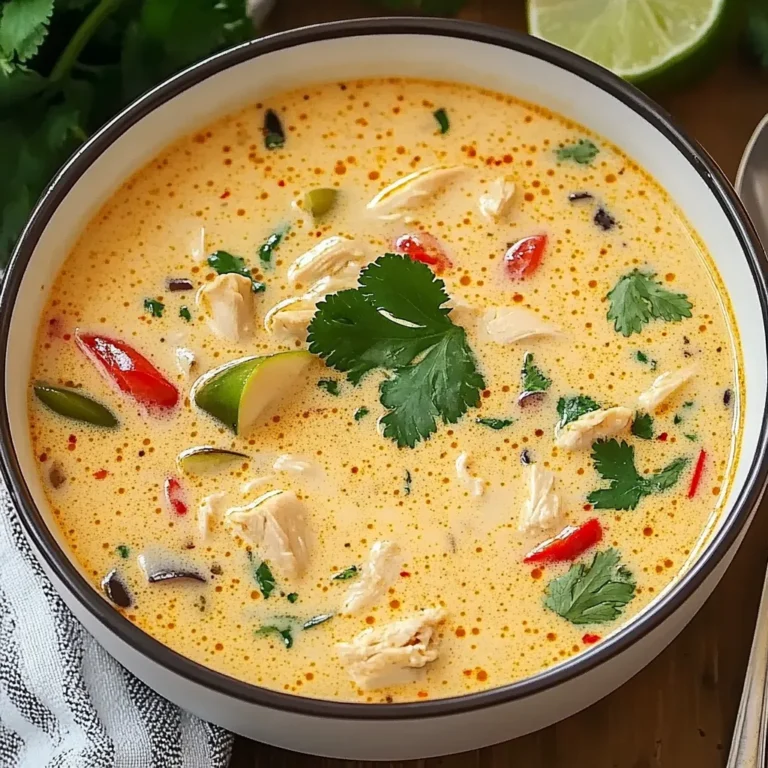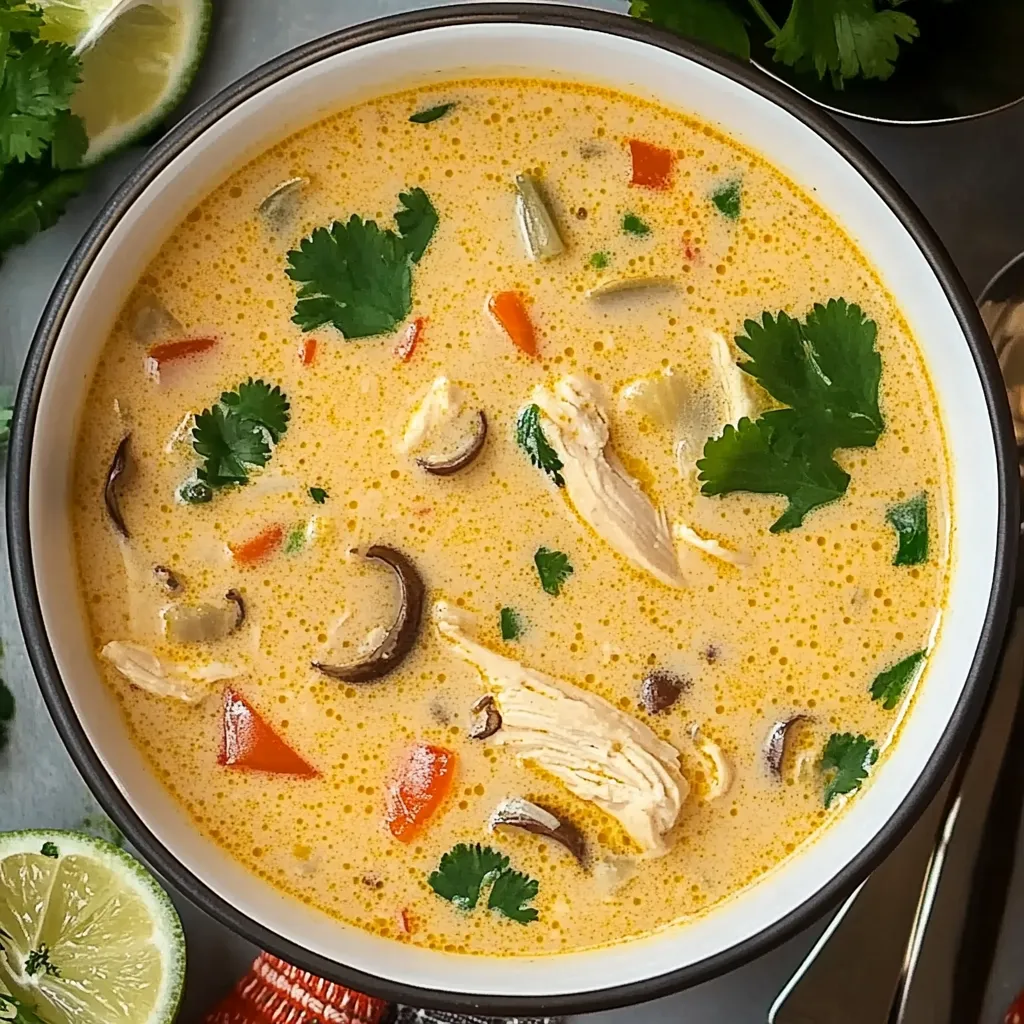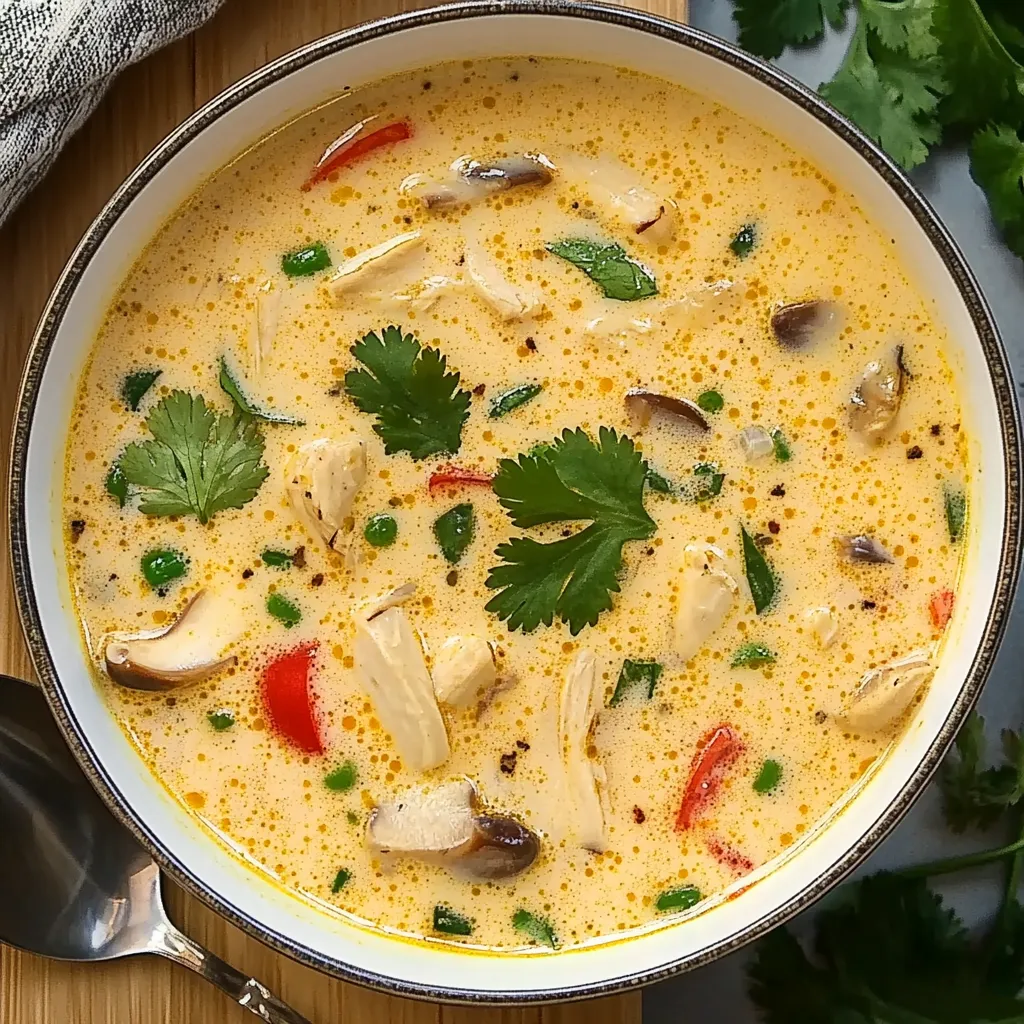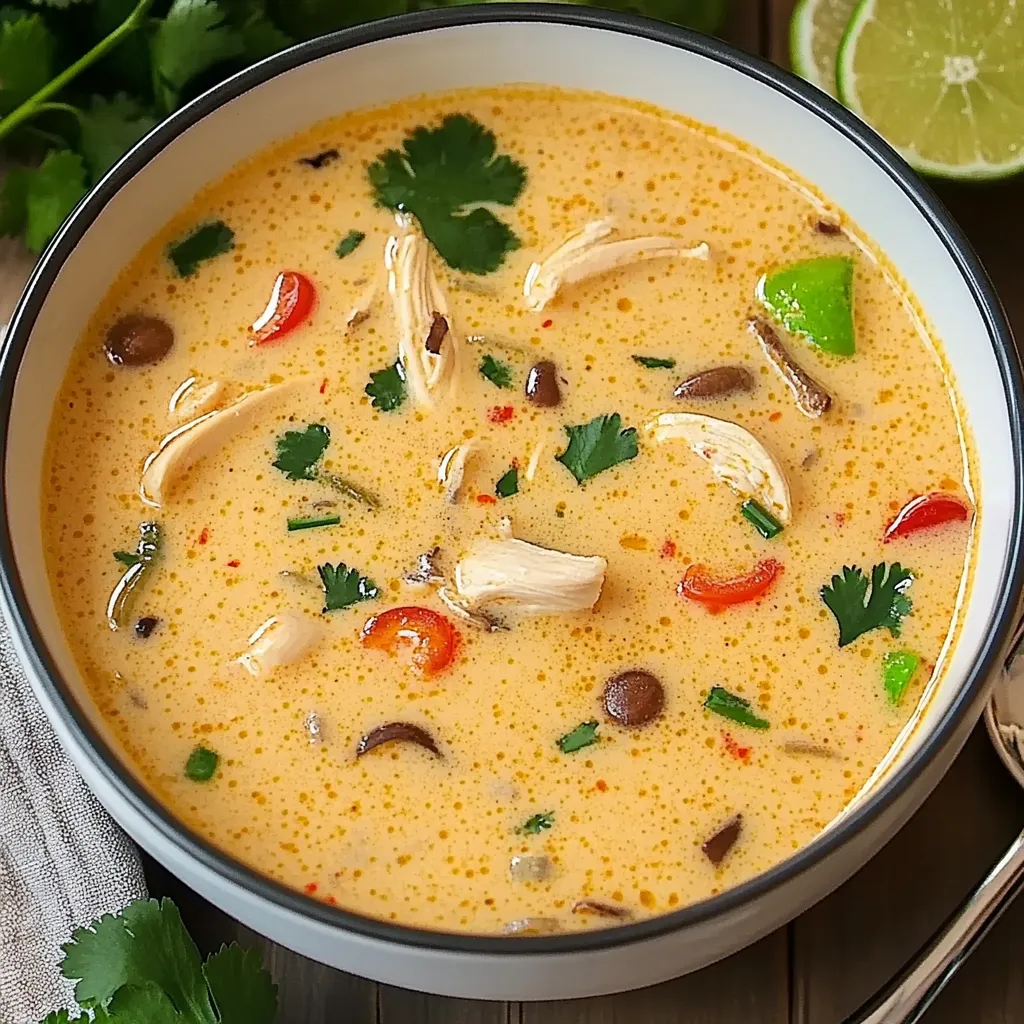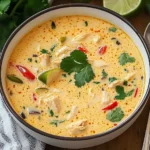Introduction to Thai Coconut Chicken Soup (Tom Kha Gai)
Tom Kha Gai is a traditional Thai coconut chicken soup that beautifully embodies Thailand’s culinary philosophy — a perfect harmony of contrasting flavors. Originating in central Thailand, this dish has become a staple in Thai cuisine, often served in homes and restaurants alike. “Tom” means “to boil,” “Kha” refers to galangal, and “Gai” means chicken. The soup is typically enjoyed as a first course, but it’s hearty enough to stand alone.
What makes Tom Kha Gai deeply rooted in Thai culture is its use of aromatic herbs and spices believed to offer healing benefits — a reflection of the country’s rich tradition of food as medicine. From its humble origins, it has gained popularity around the world for its unique and comforting taste.
Whether you’re enjoying it on a street corner in Bangkok or making it at home, it’s a dish that invites people in with its soothing warmth and vibrant complexity.
What Makes It Special?
The magic of Tom Kha Gai lies in its delicate balance of flavors — a dance between spicy, sour, sweet, and creamy. Unlike many soups that rely solely on salt for seasoning, this dish layers flavors using:
- Fresh lime juice for tartness
- Red curry paste and chiles for heat
- Coconut milk for creaminess
- Coconut sugar and fish sauce for depth
It’s this intricate layering that gives each spoonful a rich, unforgettable taste. Key to this flavor profile are signature Thai ingredients like lemongrass and galangal. Learn more about how to use lemongrass to enhance the authentic flavor of your soup, or explore the health benefits of coconut milk, one of the core ingredients that gives this dish its silky texture.
Ingredient Spotlight
Thai Coconut Chicken Soup, or Tom Kha Gai, is all about layers of aroma and flavor. Each ingredient plays a role in achieving the perfect balance — from bold and spicy to light and creamy. Understanding the key components of the dish can elevate it from good to truly exceptional.
3.1 Essential Aromatics
The base of this soup starts with a blend of traditional Thai aromatics that release flavor slowly as they simmer.
- Galangal vs Ginger
While they may look similar, galangal has a sharper, more citrusy bite compared to ginger’s warmth. If you’re after an authentic flavor, galangal is essential — it’s what gives Tom Kha Gai its signature depth. Ginger can work as a backup, but the taste won’t be quite the same. - Lemongrass
Pounded lemongrass infuses the broth with a lemony, herbal note that lifts the entire dish. Use the thick stalks, smash them with the back of a knife, and cut into chunks to release their oils. For detailed techniques, check out this guide on cooking with lemongrass. - Lime Leaves (Kaffir)
These fragrant leaves add a bright citrus aroma. Tear them slightly before adding to the soup to help release their essential oils. If you can’t find them fresh, frozen ones are a great substitute.
3.2 Protein and Vegetables
Tom Kha Gai is traditionally made with chicken, but it’s versatile enough to adapt.
- Chicken Breast
Lean and tender, sliced chicken breast absorbs flavor beautifully. Want a vegetarian twist? Sub in tofu or even shrimp for a different texture. - Mushrooms
White mushrooms are most common, but you can use oyster, shiitake, or enoki for extra umami. The soup pairs especially well with mushrooms that hold their shape when simmered.
3.3 The Creamy Base
The creaminess in this soup comes from one star ingredient: coconut milk.
- Coconut Milk vs Coconut Cream
Coconut milk offers a lighter, silkier broth, while coconut cream is thicker and richer. Depending on your preference, you can use one or a mix of both. - Choosing Quality Coconut Milk
Look for brands with a high percentage of coconut extract and minimal additives. Learn more about what makes coconut milk healthy from this detailed breakdown.
3.4 Seasonings and Condiments
A beautiful balance of spicy, sour, salty, and sweet is what makes this soup sing.
- Red Curry Paste
Adds depth, color, and heat. Use just enough to give it a gentle kick without overpowering the aromatics. - Fish Sauce, Lime Juice, and Sugar
These are your key flavor balancers:- Fish sauce adds umami and saltiness
- Fresh lime juice brings brightness and acidity
- Coconut or brown sugar rounds it all out with subtle sweetness
Mastering these layers is what makes Thai Coconut Chicken Soup more than just a soup — it’s an experience in every spoonful.
Equipment and Tools Needed
You don’t need a professional kitchen to make Tom Kha Gai, but a few essential tools will make the process smoother.
- Slow Cooker vs Stovetop
A slow cooker is perfect for deep flavor infusion, while the stovetop offers more control and quicker results. - Other Tools:
- Ladle for serving
- Fine strainer or slotted spoon to remove aromatics
- Sharp knife for slicing proteins and herbs
- Cutting board and cooking pot or slow cooker insert
Prepping Ingredients Like a Thai Chef
The way ingredients are prepared plays a huge role in building the iconic flavors of this dish. Thai cooking focuses on aromatics and their ability to release flavor through precise techniques.
- Slicing Techniques
Cut chicken into thin, bite-sized pieces to ensure quick, even cooking. Mushrooms should be sliced lengthwise so they retain their texture without turning mushy. - Crushing Lemongrass
Before adding lemongrass to the soup, use the flat side of a knife to gently crush the stalks. This releases its essential oils and allows the citrusy aroma to bloom. You can explore more about how to prep it effectively in this guide to lemongrass. - Tearing Lime Leaves
Don’t chop kaffir lime leaves. Instead, tear them slightly by hand to expose their natural oils. Their fragrant essence is what gives Tom Kha Gai its signature aroma and fresh lift.
Nutritional Benefits of Tom Kha Gai
Beyond its delicious taste, Thai Coconut Chicken Soup also offers impressive health benefits, making it a favorite for both flavor and function.
- Healthy Fats from Coconut Milk
Coconut milk is packed with medium-chain triglycerides (MCTs), a type of fat that may boost metabolism and support brain health. It also creates the soup’s creamy texture. For a deeper look into its nutrition, visit this article on the benefits of coconut milk. - Immune-Boosting Herbs
Garlic and galangal aren’t just flavor builders — they’re known for their anti-inflammatory and immune-boosting properties. These natural remedies are staples in Thai medicine, used for centuries to help fight colds and improve digestion. - Low-Carb and Gluten-Free
Naturally free of gluten and low in carbohydrates, this soup is ideal for those following keto, paleo, or gluten-free diets — without sacrificing taste or comfort.
Step-by-Step Cooking Instructions
Making Thai Coconut Chicken Soup isn’t complicated, but taking the time to build each layer of flavor is what separates a good soup from a great one. Whether you use a slow cooker or stovetop, the process is about gently extracting the natural oils and aromatics that give this dish its distinctive taste.
7.1 Prepare the Aromatics
The first step is preparing the aromatic base that forms the heart of the soup.
- Add sliced onions, chopped garlic, sliced red chili or Thai chiles, galangal (or ginger), lemongrass, and lime leaves into your pot or slow cooker.
- Stir in red curry paste until the mixture is fragrant.
Slow cooker vs stovetop:
- In a slow cooker, the aromatics develop slowly, resulting in a more rounded, mellow flavor as they steep over time.
- On the stovetop, flavors come together faster, but you’ll need to keep an eye on the heat to avoid overcooking.
Want to make the most of the herbs? Learn more about unlocking lemongrass flavor here.
7.2 Create the Flavorful Broth
Once the aromatics begin to release their oils, it’s time to pour in the chicken broth.
- Simmer the mixture for:
- 2–3 hours on high or 4–6 hours on low in a slow cooker
- 30–45 minutes on low heat on the stovetop
After simmering, use a slotted spoon or fine mesh strainer to remove the aromatics. This step ensures the soup has a clean, smooth texture without woody lemongrass stalks or overpowering bites of galangal.
This technique preserves the integrity of the broth and allows the next ingredients to shine.
7.3 Add Coconut Milk, Chicken, and Mushrooms
Now it’s time to build the body of the soup.
- Pour in the coconut milk or coconut cream. For creamy richness and added nutrition, consider learning more about the health benefits of coconut milk.
- Add bite-sized pieces of chicken breast and sliced mushrooms.
- Simmer on low until the chicken is just cooked through and tender — usually about 1 hour on high or 2 hours on low in a slow cooker, or 15–20 minutes on the stovetop.
7.4 Season, Adjust, and Final Touches
Finish the soup by balancing the key flavors.
- Stir in:
- 2–3 tablespoons fish sauce
- 2–3 tablespoons freshly squeezed lime juice
- 2–3 tablespoons brown or coconut sugar
- Taste and adjust:
- Add more lime for brightness
- More fish sauce for saltiness
- More sugar for sweetness
Once everything tastes just right, ladle the soup into bowls and top with sliced green onions and fresh cilantro. Serve warm and enjoy the complexity of flavor that makes Tom Kha Gai a Thai classic.
Tips for Perfect Thai Coconut Chicken Soup
Getting Thai Coconut Chicken Soup just right comes down to technique and timing. These tips will help you avoid common mistakes and bring out the best in your ingredients.
- Don’t boil the coconut milk
Once added, coconut milk should be gently simmered, never boiled. High heat can cause it to separate, leading to a grainy texture instead of the silky finish you want. If you’re curious about its properties, take a look at the science behind coconut milk to better understand how it behaves when heated. - Taste and adjust as you go
Thai cuisine is all about balance. Throughout cooking, taste the broth and tweak it to your liking:- More lime juice for tartness
- Extra fish sauce for depth
- A little sugar to mellow out strong flavors
A good bowl of Tom Kha Gai should hit every note — sweet, salty, spicy, and sour — in perfect harmony.
Serving Suggestions
Presentation matters, and a few final touches can transform your Thai Coconut Chicken Soup into a restaurant-worthy dish.
Garnishes:
- Chopped fresh cilantro
- Thinly sliced green onions
- Thai basil for a peppery finish
These herbs not only enhance the visual appeal but also add fresh, bright flavors to each bite. Tear them gently before sprinkling to release their oils.
Side Dishes:
- A side of steamed jasmine rice is traditional and helps soak up the rich broth.
- Pair it with crispy Thai spring rolls or a light papaya salad for a complete and satisfying meal.
Looking to experiment with Thai herbs like lemongrass and kaffir lime? Explore more tips in this Thai ingredient glossary for creative ideas beyond the classic garnishes.
Storage and Reheating Instructions
Thai Coconut Chicken Soup stores beautifully and makes for an easy, flavorful meal even days after it’s cooked.
- In the fridge:
Store leftovers in an airtight container for up to 4 days. Reheat gently on the stovetop over low heat — avoid boiling to keep the coconut milk from separating. - Freezing tips:
If you plan to freeze it, hold off on adding fresh herbs and lime juice until reheating. Freeze in individual portions for easy thawing. For best flavor, consume within 1 month.
Want to understand more about why coconut milk reacts to freezing and heating this way? Check this guide on coconut milk for helpful context.
Variations and Substitutions
Tom Kha Gai is incredibly flexible, which makes it perfect for adapting to dietary needs or flavor preferences.
- Vegan version:
Swap chicken for tofu or chickpeas, and use soy sauce or mushroom sauce instead of fish sauce. Add extra mushrooms for umami. - Spicy vs mild:
Dial back the red curry paste and chiles for a gentler broth, or spice it up with extra Thai chiles and a dash of chili oil. - Keto-friendly tweaks:
Use full-fat coconut milk and go light on sugar. Skip rice and enjoy it as-is or with a low-carb side.
For ingredient alternatives and cooking techniques, visit this excellent Thai ingredient glossary to expand your options.
FAQs
Q1: Can I use ginger instead of galangal?
Yes, ginger is a common substitute if galangal isn’t available. However, galangal has a sharper, more citrusy flavor that’s essential for an authentic Tom Kha Gai.
Q2: What’s the best substitute for lemongrass?
If fresh lemongrass isn’t available, use dried lemongrass or lemongrass paste. You can also explore how to prepare and cook with lemongrass effectively in this guide.
Q3: Is Thai coconut chicken soup spicy?
It can be, but the spice level is easy to adjust. Reduce red curry paste or chiles for a milder version, or add more for heat.
Q4: Can I freeze it?
Yes! Freeze the soup without lime juice or herbs for best results. Add those fresh when reheating. Get more info on coconut milk freezing behavior here.
Q5: What’s the difference between Tom Kha and Tom Yum?
Tom Kha is creamy and coconut-based, while Tom Yum is clear and more sour-spicy. Both use similar herbs, but their flavor profiles are distinct.
PrintAuthentic Thai Coconut Chicken Soup (Tom Kha Gai)
A warm, comforting Thai soup known for its balance of creamy coconut milk, tangy lime, savory chicken, and aromatic herbs like lemongrass and galangal. This slow-cooked version brings out deep, authentic flavors with minimal effort.
- Prep Time: 15 minutes
- Cook Time: 3–4 hours
- Total Time: 3h 15m – 4h 15m
- Yield: 4–6 servings 1x
- Category: Soup
- Method: Slow Cooker
- Cuisine: Thai
- Diet: Gluten Free
Ingredients
-
1/2 onion, sliced
-
2 cloves garlic, chopped
-
1/2 red jalapeño pepper, sliced (or 2 Thai chiles, halved)
-
3 slices galangal or ginger (1/4-inch thick)
-
1 lemongrass stalk, pounded, cut into 2-inch pieces
-
10 lime leaves, torn (optional)
-
1 tbsp red curry paste
-
4 cups chicken broth
-
2 (13.5 oz) cans full-fat coconut milk or cream
-
2 small chicken breasts (approx. 1 lb), bite-sized pieces
-
8 oz white mushrooms, sliced
-
2–3 tbsp brown sugar or coconut sugar
-
2–3 tbsp fish sauce (plus to taste)
-
2–3 tbsp fresh lime juice
-
2–3 green onions, thinly sliced
-
Chopped fresh cilantro, for garnish
Instructions
-
Prepare Aromatics:
Add onion, garlic, chili, galangal/ginger, lemongrass, lime leaves, and red curry paste to the slow cooker. Pour in chicken broth and stir. Cover. -
Cook the Base:
Cook on high for 2–3 hrs or low for 4–6 hrs. Remove aromatics with a slotted spoon. -
Add Coconut & Chicken:
Add coconut milk, chicken, and mushrooms. Cook on high for 1 hr or low for 2 hrs, until chicken is tender. -
Season:
Stir in brown sugar, fish sauce, and lime juice. Taste and adjust. -
Garnish & Serve:
Ladle into bowls and top with green onions and cilantro. Serve hot.
Notes
-
Galangal gives the most authentic flavor but ginger works well too.
-
Lime leaves enhance aroma but can be omitted.
-
Adjust fish sauce and lime juice to taste for perfect salt-acid balance.
-
Great served with jasmine rice or as a light main dish.
Nutrition
- Calories: 350 kcal
- Sugar: 6g
- Sodium: 950mg
- Fat: 26g
- Saturated Fat: 20g
- Carbohydrates: 14g
- Fiber: 2g
- Protein: 20g
- Cholesterol: 55mg

